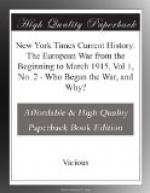Proclaim that for you the days of plunder and butchery have gone by; send messages of peace and fraternity to your fellows who have less liberty than you. Down with class rule! Down with the rule of brute force! Down with war! Up with the peaceful rule of the people! (Signed on behalf of the British Section of the International Socialist Bureau,)
J. KEIR HARDIE,
ARTHUR HENDERSON.
* * * * *
KEIR HARDIE’S QUESTIONS.
Directed at Sir Edward Grey, British Minister for Foreign Affairs, in House of Commons, Aug. 27.
Mr. Keir Hardie (Merthyr Tydvil, Lab.) asked the Secretary for Foreign Affairs whether the suggestions for a peace settlement made by the German Ambassador, ["White Paper,” Page 66, Item No. 123,] together with his invitation to the Foreign Secretary to put forward proposals of his own which would be acceptable as a basis for neutrality, were submitted to and considered by the Cabinet; and, if not, why proposals involving such far-reaching possibilities were thus rejected.
Sir E. Grey (Northumberland, Berwick)—These were personal suggestions made by the Ambassador on Aug. 1, and without authority to alter the conditions of neutrality proposed to us by the German Chancellor in No. 85 in the “White Paper”—Miscellaneous, No. 6, [1914.]
The Cabinet did, however, consider most carefully the next morning—that is, Sunday, Aug. 2—the conditions on which we could remain neutral, and came to the conclusion that respect for the neutrality of Belgium must be one of these conditions. ["Hear, hear!”] The German Chancellor had already been told on July 30 that we could not bargain that way.
On Monday, Aug. 3, I made a statement in the House accordingly. I had seen the German Ambassador again at his own request on Monday, and he urged me most strongly, though he said that he did not know the plans of the German military authorities, not to make the neutrality of Belgium one of our conditions when I spoke in the House. It was a day of great pressure, for we had another Cabinet in the morning, and I had no time to record the conversation, and therefore it does not appear in the “White Paper”; but it was impossible to withdraw that condition [loud cheers] without becoming a consenting party to the violation of the treaty, and subsequently to a German attack on Belgium.
After I spoke in the House we made to the German Government the communication described in No. 153 in the “White Paper” about the neutrality of Belgium. Sir Edward Goschen’s report of the reply to that communication had not been received when the “White Paper” was printed and laid. It will be laid before Parliament to complete the “White Paper.”
I have been asked why I did not refer to No. 123 in the “White Paper” when I spoke in the House on Aug. 3. If I had referred to suggestions to us as to conditions of neutrality I must have referred to No. 85, the proposals made, not personally by the Ambassador, but officially by the German Chancellor, which were so condemned by the Prime Minister subsequently, and this would have made the case against the German Government much stronger than I did make it in my speech. ["Hear, hear!”] I deliberately refrained from doing that then.




